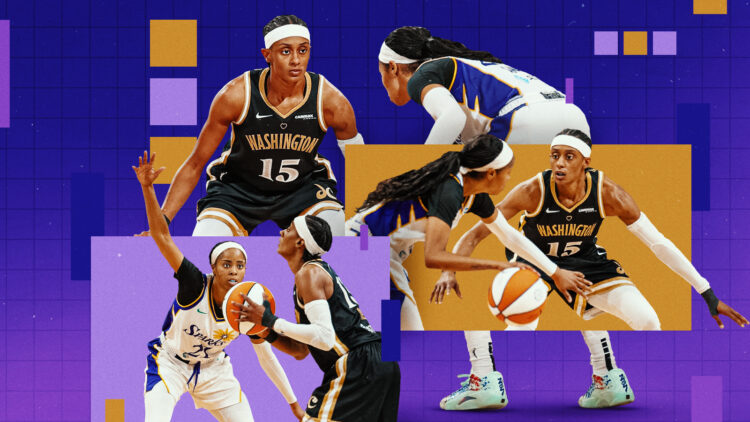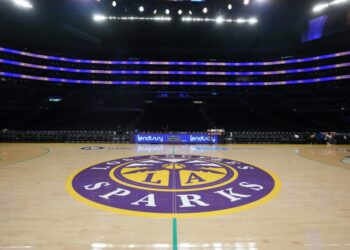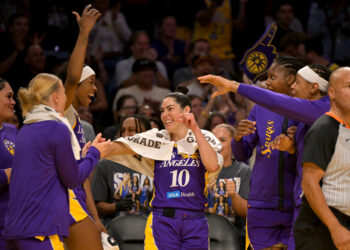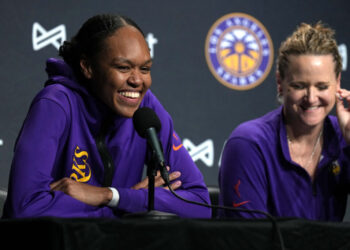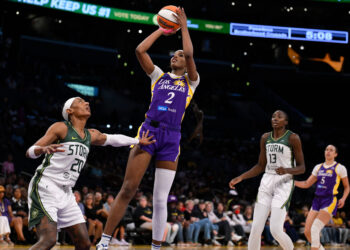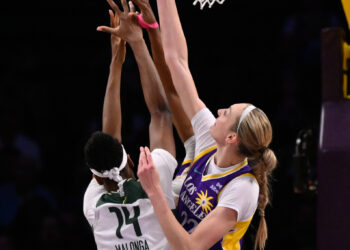It’s funny how article topics come about. Sometimes they’re based on a theory. Sometimes they’re based on something I see and want to explore more. Sometimes there’s a story I feel needs to be told. And sometimes, a head coach may just informally challenge you to write about something.
The last scenario is the reason why this article exists. On Aug. 4, I was the lone media representative in Entertainment & Sports Arena’s visiting presser room following the matchup between the Los Angeles Sparks and the Washington Mystics. During my exclusive with Sparks head coach Curt Miller, I asked him about Jordin Canada’s two-way play. He responded, “What won’t get written about is I think you have the two best guard defenders in the league tonight. Between Brittney [Sykes] and Jordin [Canada], you have two elite defenders. We ask [Canada] to run around, chase around the best players on opponents’ teams each and every night.”
This piqued my interest, both because Miller unintentionally challenged me that no one would write this article and also because I wanted to see if he was right.
So with that, I set out to find an answer—is Miller correct? Are Sykes and Canada the best on-ball guard defenders in the W?
Jumping to Conclusions
A couple pieces of evidence that support Miller’s claim are that both Sykes and Canada are really good at reading gaps and jumping passing lanes for easy steals. Eric Thibault, head coach of the Mystics, assessed the same thing: “I think Jordin and Slim [Sykes] have similarities in terms of how they play passing lanes. They’re not built similarly, but Jordin [is]really good at baiting a pass and shooting the gap, so her and Slim are very alike in that way.”
Canada is incredibly adept at reading passing lanes and jumping them for steals. In the clips above, note that Canada’s eyes are always watching and anticipating where the pass will go. Her exceptional athleticism gives her one of the quickest first steps in the league, which allows her to sag off her assignment to help in rotation. It also allows her to pick her spots, read the play developing, and then pounce when the offense least expects it.
The only other person in the league who does this as well as Canada is indeed the Mystics’ Sykes. Her instincts are so sharp that she reads the offense like a book, jumping passing lanes with her elite speed and athleticism. The clips above highlight these characteristics. What’s clear is that both Canada and Sykes have the agility and quickness to read and react defensively.
On-ball Defensive Deftness
When it comes to on-ball defense, there may not be two players in the league with faster hands than Sykes and Canada. It’s almost as if they spend every waking moment studying their opposition, aiming to exploit their weaknesses by learning their each and every move. Their ability to disrupt even the best handles is a testament to their basketball acumen and intuition for when to snatch the ball from their opponent.
The clips above demonstrate Sykes’ ability to move with her defender and shut down their ability to get loose off the dribble. Her hands, vision, and overpowering athleticism give her all of the advantages. She is consistently looking for the ball and expects to take it from her opponent on each possession.
Furthermore, Sykes’ ball denial skills are equally astounding. In the clip below, Sykes’ footwork allows her to remain attached to her assignment and keep the ball out of their hands, only to then use that attachment to her advantage and force a turnover.
To her credit, Canada is a similar on-ball threat, utilizing the same basketball IQ, nimbleness, and vision to snatch and poke away balls from her assignments. However, the difference in teammate personnel between Canada and Sykes makes this a particularly challenging task for Canada. Each game, Canada is assigned to the opponent’s best offensive player, whereas Sykes will only see that player on occasion because she shares that role with Ariel Atkins and Natasha Cloud. This makes what Canada does even more impressive.
Both of the clips above exemplify the defensive menace that, like Sykes, Canada is capable of being.
How Do They Compare?
Both Sykes and Canada are capable and pesky defenders, but while we’ve acknowledged that ability within their basketball profiles, we still have yet to answer the true question here. To find out if they are indeed the best at what they do, we need to move beyond the eye test and to the numbers. Let’s take a look at their stat comparisons.
| Statistic | Jordin Canada (League Rank) | Brittney Sykes (League Rank) |
| DRTG* | 96.4 (15th) | 98.7 (33rd) |
| SPG | 2.0 (T-2nd) | 2.2 (1st) |
| Oppo TOVs (per 100 poss)* | 19.5 (T-9th) | 20.2 (5th) |
| Oppo TOVs (per game)* | 12.9 (3rd) | 12.5 (5th) |
| Def WS* | 0.172 (5th) | 0.135 (T-11th) |
| PPP Against | 0.771 | 0.760 |
| Oppo FG% (25-29 FT)^ | 28.6% (16th) | 30.6% (28th) |
| Oppo Guards’ FG%* | 44.8% (T-58th) | 44.8% (T-58th) |
| Oppo 3PT%* | 30.9% (8th) | 35.8% (T-65th) |
| Personal Fouls (per game)* | 2.3 (T-31st most) | 3.0 (T-8th most) |
| * indicates statistic based on WNBA guards who average 11.0+ minutes per game (MPG) in 20+ games played during the 2023 season ^indicates statistic based on WNBA guards Stats as of Aug. 16 and courtesy of WNBA.com and Synergy Sports | ||
The analytics support the eye test—in some respects, that is. Both Sykes and Canada are truly outstanding defensive players, especially in their ball thievery. In accounting for the conditions assigned to the stats in the chart above, we can see that while Canada and Sykes have solid enough defensive ratings (DTG), they are not in the top five in that category. But that doesn’t mean they aren’t great defenders.
Excluding Evina Westbrook (new to the team) and Rae Burrell (sparingly used reserve player), Canada has the best DRTG on the Los Angeles Sparks when she’s on the court. The Sparks also have the worst DRTG when Canada is off the court, and she sports the highest DRTG differential on the team, excluding Burrell and Westbrook. This is a clear indicator that Canada is especially impactful defensively, both on her team and overall.
For her part, Sykes, excluding Abby Meyers (new to the team, hardly used, and cut) and Amanda Zahui B. (traded earlier in the season), has the seventh-best DRTG and third-best among guards on her team. Additionally, the Mystics have the sixth-worst DRTG with her off the court. Not including Meyers, Sykes has the third-highest DRTG differential on the team among guards. While Sykes has certainly held her own, especially with plenty of injuries to her teammates, she’s clearly not the best defender on her own team on a consistent basis, just in small spurts.
The defensive win shares (DWS) surely prove these two as elite on-ball defenders, but some of the opponent numbers give me pause. While perimeter defense isn’t the end-all-be-all for guard defenders, it is the area on the court where you will defend the most and be an on-ball defender the most (excluding players driving on you in the paint, etc.). With that in mind, seeing that both Sykes and Canada are barely within the top 30 in opponent field goal percentage (Oppo FG%) from that perimeter range makes me cautious to consider them top-of-their-class defenders.
Moreover, the opponent’s field goal percentage overall among guards is another concerning statistic. While there are certainly a number of factors to consider (such as the fact that defensive numbers like these are very much connected to overall team defense and the individual defensive metrics of the other four players on the court), it nevertheless makes me wonder if Miller was indeed using the eye test more than analytics.
Verdict
I agree with Miller’s assertion that Sykes and Canada are incredibly influential on the defensive side of the ball. However, I believe the eye test speaks greater volumes than what the analytical numbers can back up. Do I want both of these players on my team? Without question, but that doesn’t mean I view them as the best two on-ball defenders in the league.
All stats as of Aug. 16. Unless otherwise noted, all stats courtesy of WNBA.com.
